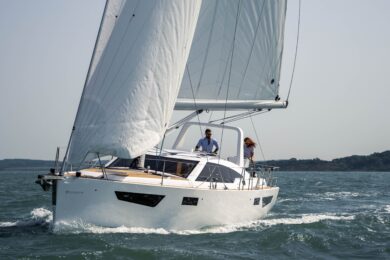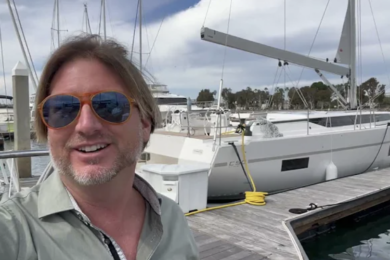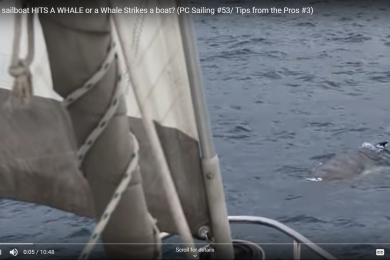After days of sailing through heavy wind and weather in the South Pacific, a stop at Minerva Reef offers a chance to regroup (published Dec/Jan 2016-17)
We’re about 800 miles north of New Zealand, six days into our sail to Tonga with more wind, wilder waves, and more violent squalls than the forecasters predicted. We want to sleep in a bunk that isn’t pitching wildly. We want to eat a hot meal that isn’t flying off the plate or out of our stomachs. We want to stop, but we’re still 250 miles from our ultimate destination. Our nautical charts tell us we’re near something like land. All I can see is sea.
 Standing on the bow of our 41-foot sailboat, pitching a few feet above the surface of the Pacific Ocean, I’m desperately seeking North Minerva Reef and the only indication is a slight interruption in the eternal seascape of swell chasing swell, where the whitewashing waves seem to break in a different pattern.
Standing on the bow of our 41-foot sailboat, pitching a few feet above the surface of the Pacific Ocean, I’m desperately seeking North Minerva Reef and the only indication is a slight interruption in the eternal seascape of swell chasing swell, where the whitewashing waves seem to break in a different pattern.
There was a time not long ago when sailors like us would have actively avoided this place. North Minerva Reef isn’t really land. Imagine the rim of a cereal bowl barely submerged in a sink full of water. If we were birds, we could soar above and see the thin circle of coral reef, the barely visible remains of a collapsed volcano, like the letter C penciled onto paper then erased. Its cousin, South Minerva, 15 miles away, looks like an erased figure 8. At low tide, about three feet of coral and rock are exposed; at high tide, there’s nothing but water, though the rim of the reef is just high enough to hold back the full force of the waves, like a bodyguard braced against the melee of the crowd. If we can get inside the lagoon, we’ll be able to drop our anchor in 50 feet of calm water and take a much-needed break.
A spot in the ocean
We sail cautiously closer, searching for the slight break in the coral like a sliver of a slice taken from a pie, where we might dare to enter the lagoon. In this modern age of pinpoint precise GPS and radar, Minerva Reef has become a destination for voyaging sailors, a welcome respite from the sometimes tiresome task of negotiating wind and waves to one’s advantage, but our paper chart still shows it as a tiny speck, the text bigger than what it names. The electronic chart is only slightly more suggestive that the lagoon entrance is on the northwest side. Warwick Clay, author of South Pacific Anchorages writes that the pass is easily navigated and praises the obstruction-free, calm conditions to be found in the lagoon, then states, without elaboration: “I found the navy chart in error.” Fears run high that we could be on the brink of a shipwreck. Help would be many days and hundreds of miles away, if it all.
The reefs are about 250 miles southwest of Tonga, 250 miles southeast of Fiji, and the two countries have been fighting over them for years by erecting simple structures to solidify their claims. They take turns destroying anything the opposite country has built that the waves haven’t already washed away. Sailors are warned not to rely on any information about lights and aids to navigation. At the moment, we’ve been told Tonga owns a single light planted on the southwest edge of the reef. More a light stick than a lighthouse, it’s a short, simple, solar powered staff blinking a white light twice every twenty seconds. It wasn’t placed in a helpful location, such as the entrance to the lagoon, and seems to communicate nothing except, “I am here and here is land. Sort of.”
Brian and I have a combined 35,000 nautical miles of sailing between us. He’s owned the boat for 25 years and we’ve lived aboard together for seven, traveling in, around, and between 12 different countries, but the past six days have exhausted us. We’re seasick and feeling out of sorts, as if we hadn’t properly prepared—physically or mentally—for this trip. It feels like we’re out of practice, the skin of our hands gone soft and tender from sitting around in a marina, our eyes and hearts dulled by the daily grind of 9-5 jobs, our minds newly baffled by the patience and vigilance required to voyage long distances.
There are moments at sea when the audacity of what you’re doing strikes like lightning. The strength of your boat seems questionable, the rig a fragile construction of sticks and wire, the sails mere strips of cloth, the hull no match for the waves punching it like a giant’s mean right hook. I feel caught in one of those moments as we approach what we think is the entrance to the lagoon, snagged between the exhausting reality of sailing on and the possibility of safe harbor, the fear that we might be making a terrible decision and the courage to go through with it anyway.
And then there is the relief of calm water and I am here, and here is land. Sort of.
To anchor a boat in what feels like the middle of the ocean is the strangest thing. When we sail offshore, we are accustomed to the view of sky on sea, but it’s accompanied by measured motion, unintentional drift, the act of travel and all its expectations and anticipation. Anchored in Minerva Reef, our motion is arrested, but we have no landmarks, no hills or beaches or buildings or other boats as points of reference or curiosities to explore. It’s like being hove-to, when you back the sails so they work against each other and instead of sailing forward, the boat simply drifts. It’s a storm tactic often used by sailors, a way to slam on the brakes and fix something, cook a meal, take a break, or wait for conditions to change.
A place just to be
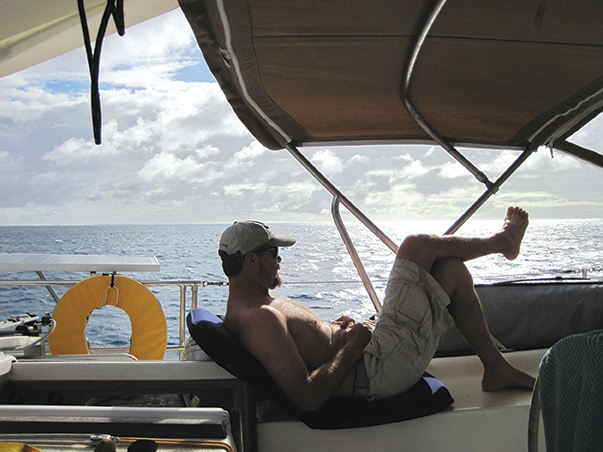
Minerva Reef defies photography. It’s like trying to shoot the ocean during a hurricane or the 360-degree view from the top of a mountain: there’s no way to capture the scale, the greatness, the lack of boundaries, the spatial sense of nothing and everything. Minerva Reef is less a place to see than a place to be. It’s where we wait for the sun to rise, for the sun to set, for the yeast to bubble, for the dough to rise, for the storm to pass, for the wind to die. It requires the same patience and endurance as sailing, but with this beautiful pause in our motion. Being here is like holding a breath before you do something huge. It’s like dwelling between the past and the future, where you’ve been and where you’re going.
There aren’t many times or places where a person is physically in-between, and most of them involve transit: cars and cabs, subways and elevators, ferries and flights. These days, in these places, technology takes over and tames the spikes of anticipation and boredom, staves off the desire to just get there, or not get there if you’re on the way to the dentist or your in-laws.
How often do we get to dwell in- between? When are we really comfortable with waiting for as long as it takes, poised in-between departure and arrival, existing in a place that isn’t your destination, that’s barely a place at all?
At high tide, Minerva Reef is awash with water and a gentle swell sways the boat. At low tide, about a meter’s height of reef is exposed in some places, with a few conspicuous rocks interrupting the flat horizon. I find myself staring at them, as if they are stage props concealing the imminent villain. As if something will suddenly appear.
There is nothing to do but observe the elements at play. The bucking spumes of spray flying high off the reef. The capping fetch inside the lagoon lifting and jigging our anchored boat. The gathering grey of a squall on one horizon, the fluffy, flat-bottomed tradewind clouds on the opposite horizon. Without landmarks, perspective feels skewed. The compass tells me we are on the eastern side of the reef and that the wind blows easterly at us, but it isn’t until the moon rises, a known fix in the sky, that I feel where east is. The feeling of west comes with the late afternoon sun, coating the cockpit where we sit and sip gin and tonics and talk about our day as if we haven’t spent it entirely together, orbiting around the boat and each other. The sun is bright and rich as warm butter and we baste ourselves in it, warming away the New Zealand winter we narrowly escaped and the arduous six days and nights of hard sailing.
Few people have been to Minerva Reef. It’s a destination for very adventurous in-the-know divers and deep-sea fishing charter boats. South Pacific sailors occasionally mention it as a place to dodge bad weather on the passage to and from New Zealand, which few can sail without at least one passing low-pressure system kicking up uncomfortable conditions. Most view it as a place to pull over for a night or two while the low passes or the wind shifts. We stayed for 12 days.
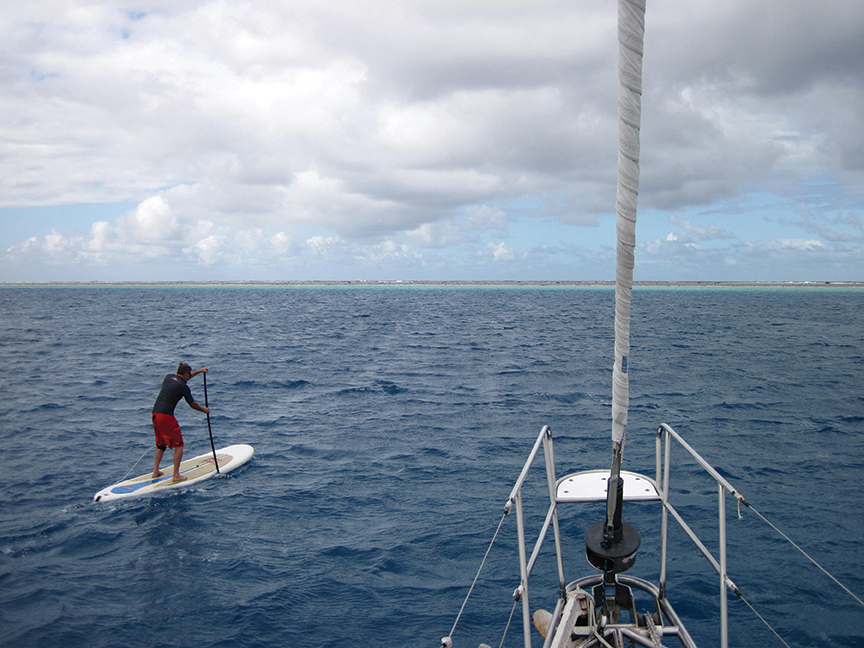 For 12 days, our lives are hove-to. Everything that grabbed our attention, the flurry of freelance work, fixing up the boat, keeping up communications with family and friends too many time zones away, is paused while we straighten up our ship and our relationship to it and each other. For the first time, in a long time, the whole world is just me and Brian and the boat, the weather, the wind, and the few things that drift into view. We read. We eat. We swim. We fix things. We talk. We tell stories we’ve never told. We marvel at the strangeness of this place. We get comfortable with the idea of what’s next. This time in- between sets the pace for the coming years, cruising between countries, sailing to more places we’ve never been and can’t imagine, heading back to the US and the place we remember best. “I feel like I’m molting,” Brian says one night. “Like I’m shedding the skin I grew to live as an immigrant so I can be back in my native land.”
For 12 days, our lives are hove-to. Everything that grabbed our attention, the flurry of freelance work, fixing up the boat, keeping up communications with family and friends too many time zones away, is paused while we straighten up our ship and our relationship to it and each other. For the first time, in a long time, the whole world is just me and Brian and the boat, the weather, the wind, and the few things that drift into view. We read. We eat. We swim. We fix things. We talk. We tell stories we’ve never told. We marvel at the strangeness of this place. We get comfortable with the idea of what’s next. This time in- between sets the pace for the coming years, cruising between countries, sailing to more places we’ve never been and can’t imagine, heading back to the US and the place we remember best. “I feel like I’m molting,” Brian says one night. “Like I’m shedding the skin I grew to live as an immigrant so I can be back in my native land.”
Perhaps that is the value of these in-between places, these spaces where we find ourselves without traffic or company, without phone in hand or instant internet connection, without any particular thing to do and all the time to do it. It’s a place to feel human and vulnerable. The void of clutter, the lack of perspective in all this water, shifts your vision. Your eyes focus on what’s directly in front of you and what, in fact, matters most—salvaging the best parts of the last fresh apple, rising in the middle of the night to make sure the boat is still where it was when the sun went down, watching Brian, head bent at his tool bench, and seeing traces of the quiet boy he must have been, reading so closely from the book in my hand that when I close my eyes I see Comanches racing ponies.
When we are cruising, the boat has to be so many things: our home and country, our mode of travel and haven from the elements. In a place like Minerva Reef, all the virtues of the boat are exposed. We remember how self-sufficient we are, what little we need and how it’s all aboard—three months of water, three months of cooking propane, weeks and weeks of food, electricity gathered daily via solar and wind, updated weather forecasts via single sideband radio, a couple of hundred books to read and read again, an iPod that would take many days to shuffle through every song, a snorkel, mask and fins when it’s TV time. This is where joy is bared.
That’s the reason to heave-to and dwell in an in-between place. Twelve days slide by, each one alike, each one worthy of its own name. The Day After We Arrived. The Day it Rained. The Day We Swam to the Reef. Fresh Bread Day. The Day the Other Boat Arrived. The Day the Other Boat Left. Solstice. The Day it Blew from The North. The Day We Saw A Bird. The Day We Fixed Everything. The Day We Decided to Leave. The Day We Left.
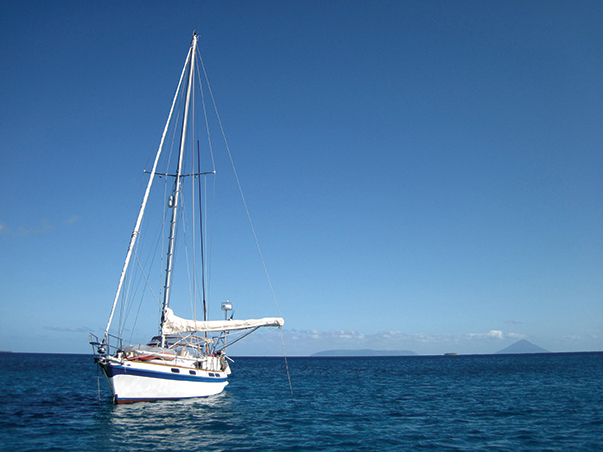
Later, when we tell other sailors who have been to Minerva Reef, that we stayed there for 12 days, most of them say, with a bit of incredulity, “Twelve days? But what did you do?”
Do? We were just being.
Amanda Witherell is a sailmaker and journalist, living with her partner, Brian Twitchell, aboard a 1974 Morgan Out Island 41, Clara Katherine, out of San Diego, California. Since 2009, they’ve been cruising Central America and the South Pacific, including four years working in New Zealand.

